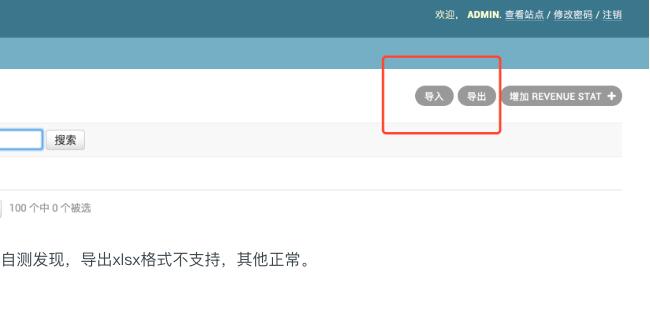溫馨提示×
您好,登錄后才能下訂單哦!
點擊 登錄注冊 即表示同意《億速云用戶服務條款》
您好,登錄后才能下訂單哦!
使用django-import-export庫,導入導出數據,支持csv、xls、json、html等格式
官網:http://django-import-export.readthedocs.io/en/latest/installation.html
1、安裝django-import-export
pip install django-import-export
2、配置settings.py
INSTALLED_APPS = ( 'django.contrib.admin', 'django.contrib.auth', 'django.contrib.contenttypes', 'django.contrib.sessions', 'django.contrib.messages', 'django.contrib.staticfiles', 'customer', 'publisher', 'import_export', )
執行命令: python manage.py collectstatic
3、models.py 建立model
class Author(models.Model):
name = models.CharField(max_length=100)
def __unicode__(self):
return self.name
class Category(models.Model):
name = models.CharField(max_length=100)
def __unicode__(self):
return self.name
class Book(models.Model):
name = models.CharField('Book name', max_length=100)
author = models.ForeignKey(Author, blank=True, null=True)
author_email = models.EmailField('Author email', max_length=75, blank=True)
imported = models.BooleanField(default=False)
published = models.DateField('Published', blank=True, null=True)
price = models.DecimalField(max_digits=10, decimal_places=2, null=True, blank=True)
categories = models.ManyToManyField(Category, blank=True)
def __unicode__(self):
return self.name
4、在admin.py 創建Resource、對應的Admin
from import_export import resources
from core.models import Book
from import_export.admin import ImportExportModelAdmin
class BookResource(resources.ModelResource):
class Meta:
model = Book
export_order = ('id', 'name', 'author', 'author_email', 'imported', 'click', 'published', 'price', 'categories')
@admin.register(Book)
class BookAdmin(ImportExportModelAdmin):
list_display = ('name', 'author', 'author_email', 'imported', 'published', 'price', 'categories')
search_fields = ('name', 'author','published')
date_hierarchy = 'date'
resource_class = BookResource
export_order:設置導出字段的順序
5、Django界面實現導入導出

自定義導出 方式 action 這種方式也推薦
import xlwt
#導出Excel
from django.http import StreamingHttpResponse
class AdminReport(admin.ModelAdmin):
actions = ["saveexecl"] # 自定義的action(導出到excel表格)
list_display = ("id",'offer','day_time', 'idfa', 'submit_result_text', 'callback_result_text') # 顯示的列
search_fields = ('day_time','callback_result_text') # 可以搜索的字段
date_hierarchy = 'day_time' # 按照日期顯示
list_filter = ('offer',) # 過濾條件
list_per_page = 500 # 每頁顯示500條,太多了可能會出現服務器崩掉的情況
def saveexecl(self,request,queryset):
Begin = xlwt.Workbook()
sheet = Begin.add_sheet("response")
cols = 0
for query in queryset:
# you need write colms # 好像有個方法可以一次性寫入所有列,記不清了,只能用這種簡單的方法去實現
sheet.write(cols,1,str(query.idfa)) # 寫入第一列
sheet.write(cols,2,str(query.day_time)) # 寫入第二列
sheet.write(cols,3,str(query.keyword)) # 寫入第三列
cols += 1
Begin.save("%s" %(filename))
def file_iterator(filename,chuck_size=512):
with open(filename,"rb") as f:
while True:
c = f.read(chuck_size)
if c:
yield c
else:
break
response = StreamingHttpResponse(file_iterator(filename))
response['Content-Type'] = 'application/octet-stream'
response['Content-Disposition'] = 'attachment;filename="{}"'.format("result.xls")
return response
saveexecl.short_description = "導出Excel" # 按鈕顯示名字
admin.site.register(Report, AdminReport) # 注冊到admin
以上這篇Django import export實現數據庫導入導出方式就是小編分享給大家的全部內容了,希望能給大家一個參考,也希望大家多多支持億速云。
免責聲明:本站發布的內容(圖片、視頻和文字)以原創、轉載和分享為主,文章觀點不代表本網站立場,如果涉及侵權請聯系站長郵箱:is@yisu.com進行舉報,并提供相關證據,一經查實,將立刻刪除涉嫌侵權內容。